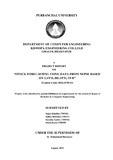Please use this identifier to cite or link to this item:
https://elibrary.khec.edu.np:8080/handle/123456789/676Full metadata record
| DC Field | Value | Language |
|---|---|---|
| dc.contributor.advisor | Dr. Mahammad Humayoo | - |
| dc.contributor.author | Sajan Khadka (750336) | - |
| dc.contributor.author | Salina Shrestha (750337) | - |
| dc.contributor.author | Susmita Gaihre (750346) | - |
| dc.contributor.author | Sweta Karn (750349) | - |
| dc.date.accessioned | 2023-09-20T12:23:41Z | - |
| dc.date.available | 2023-09-20T12:23:41Z | - |
| dc.date.issued | 2023-08 | - |
| dc.identifier.uri | https://elibrary.khec.edu.np/handle/123456789/676 | - |
| dc.description.abstract | Stock price forecasting has long been a challenging and crucial task in financial markets. In this project, we propose a comprehensive investigation into the performance of various predictive models, including Long Short-Term Memory (LSTM), Bidirectional LSTM (BiLSTM) and Support Vector Regression (SVR) for predicting the closing prices of companies listed on the Nepal Stock Exchange (NEPSE). The objective of this project is to test which model most accurately captures and predicts stock market patterns on the NEPSE. The dataset used comprises historical stock prices, trading volumes, and other relevant features from NEPSE. This study not only explored the intricacies of stock price forecasting but also utilized three distinct models LSTM, BiLSTM, and SVR to predict prices for the upcoming seven days, providing a foundation for informed investment decisions. Our experimentation involves a comparative analysis of the three selected models. The LSTM and BiLSTM models, known for their ability to capture long-term dependencies in sequential data, are implemented to exploit the temporal relationships present in stock price time series. SVR, a popular machine learning regression algorithm is also included in the analysis for comparison. The performance of each model is evaluated using various metrics such as Mean Squared Error (MSE), Root Mean Squared Error (RMSE) and Mean Absolute Error (MAE). Our experimental results demonstrate that the BiLSTM model outperforms the other models in terms of prediction accuracy and ability to capture intricate price patterns present in NEPSE stock data. The BiLSTM model's success can be attributed to its capability to handle sequential data effectively, making it particularly well-suited for stock price forecasting. | en_US |
| dc.language.iso | en | en_US |
| dc.subject | Nepal Stock, LSTM, RNN, SVM, BILSTM | en_US |
| dc.title | STOCK FORECASTING USING DATA FROM NEPSE BASED ON LSTM, BILSTM, SVR | en_US |
| dc.type | Technical Report | en_US |
| local.college.name | Khwopa Engineering College | - |
| local.degree.department | Department of Computer | - |
| local.degree.name | BE Computer | - |
| local.degree.level | Bachelor's Degree | - |
| local.item.accessionnumber | D.1371 | - |
| Appears in Collections: | PU Computer Report | |
Files in This Item:
| File | Description | Size | Format | |
|---|---|---|---|---|
| STOCK-FORECASTING.pdf Restricted Access | 2.25 MB | Adobe PDF |  View/Open Request a copy |
Items in DSpace are protected by copyright, with all rights reserved, unless otherwise indicated.
